The 4th of July weekend looked very promising for diving of the coast of New Jersey. The four of us that go together choose to do a two tank dive on Saturday, July 3nd and a single tank dive on Monday, July 5th. Veronica goes back to being with our son, Tom, on Tuesday and I am back to work/taking Veronica and Tom to the hyperbaric chamber in Mt. Vernon, NY. The weather gods were with us on Saturday. We left the dock at 7:00am to sunny skies and light winds. We were not alone. Lots of fishing boats were exiting Manasquan Inlet on their way to reefs and wrecks for black sea bass and blackfish (tautog), to the sandy flats for fluke (summer flounder) and to the rock piles and jetties for striped bass.
We left the inlet and decided to give a try for the Mohawk shipwreck. It is about a 7 1.2 mile run from Manasquan Inlet. She was a passenger liner that was sunk in a collision with the freighter Talisman in 1935. She doesn’t resemble a ship anymore. The Navy used over 8 tons of dynamite to demolish her. She was wire dragged to maintain a depth of 50’ over the wreck to keep her from being a hindrance to navigation.
When we arrived at the site, I was surprised to only find one fishing boat on the wreck. Lately, it has been tough finding a spot as the wreck fishermen are loving the action on the reefs and wrecks. The Mohawk is large so it is not difficult for two boats (or more) to be on the site at the same time. As I approached the wreck, I saw our friends, Paul and Ruth Hepler, who run the Venture III, a commercial SCUBA diving charter boat approaching.
In what is an unusual happening for me, I told my friends to drop the marker buoy and then a minute later, told them to drop the hook. We use a grapple type hook to hook into artificial reefs and shipwrecks. Ours is light weight and made of stainless steel. We have more than ten feet of chain at the anchor to help keep it on the bottom when we are dragging to hook in.
There was about 75 feet between our boat and the fishing boat. Paul brought the Venture III in right between us and dropped his hook. Paul uses a different approach. He drops a Danforth anchor in the sand and then drifts over the wreck and drops his wreck anchor straight down. One of his divers will go in and wrap the anchor line around a piece of wreckage to hold it in place. Paul’s divers have a shorter swim to reach the bottom than we do.
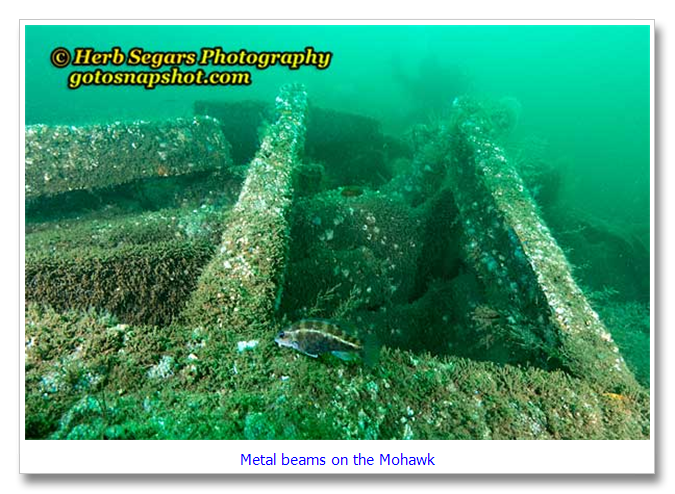
Beth was bringing her underwater camera for the first time today. She uses a point and shoot Nikon camera in an Ikelite housing. Her husband, Wes, bought her an Ikelite strobe for Christmas. Last year, she tried using the flash built into the camera but it did not give out enough light and part of the flash was cut off by the housing. The new flash uses a sensor to sense the light from the on-camera flash and then it fires the external flash. I am anxious to see her results.
And here is one of Beth’s photos from our dive. I think that it’s great.
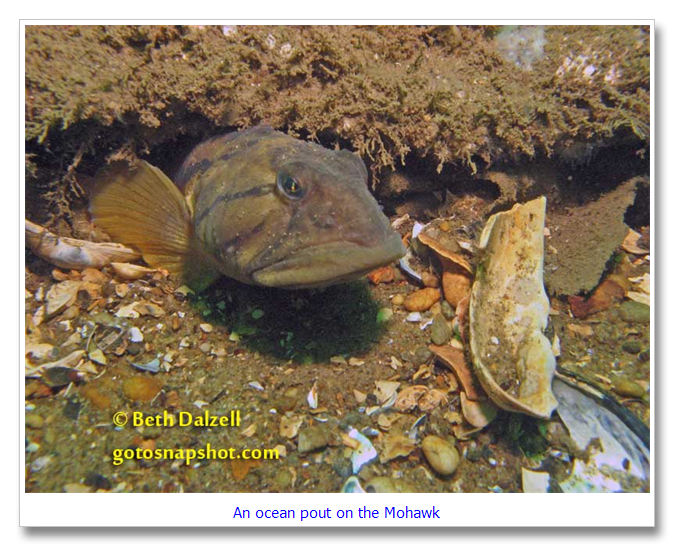
I got my rig ready. Today, I used a Nikon D300 in a Subal housing with a Tokina 10-17mm fisheye zoom lens, a Zen 100mm (4”) port and twin Ikelite DS-125 strobes. One of the most difficult things with wide angle photography in New Jersey is lack of light at the bottom. Visibility or lack of it is also and issue that makes wide angle photography difficult.
Paul’s divers got into the water first and Beth and I headed for the bottom a few minutes later. The visibility in the first 40’ of water column was beautiful. I was hoping that I would see something to shoot in the water column but that was not to be. I kept going down. The first change that I noticed was the temperature. The surface temperature was around 68°. At the bottom it was a refreshing (????) 52°. Visibility on the bottom was around 15’. This was enough for me to try and work some magic.
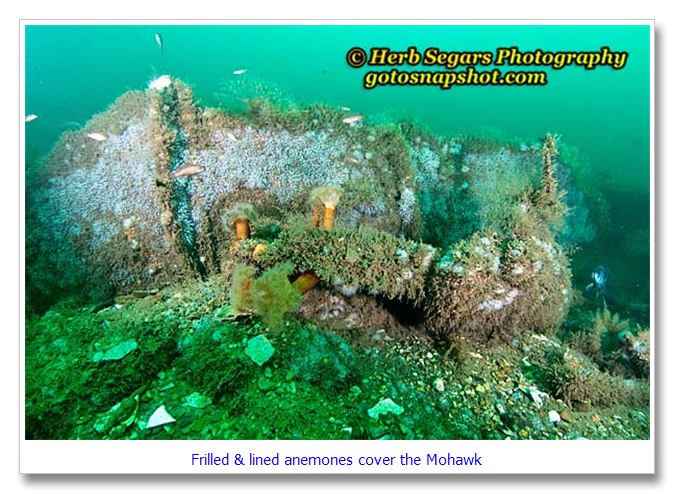
First thing that I do on the bottom is turn on my strobes and camera, position the strobes where I feel that they belong and then take a meter reading of the available light. My secret to shooting wide angle photos in New Jersey is to try and match the output of my strobes to the available light. I let the light do most of the work and use the strobes to provide color to the photos. This is much easier with a digital camera than it was with film. When I shot film, I would pick a film speed (ISO) before the dive and I would be stuck with that speed. I could push it one or two speeds but with digital, I can decide on the bottom which ISO to use and I can even change that between shots.
I took a meter reading and decided on an ISO of 640. I used a lens opening of f11 and a shutter speed that ended up varying between 1/6th and 1/15th of a second. My strobes were on half power. I started off taking shots of some of the wreckage and was enjoying myself when I saw some movement out of the corner of my eye.
It was some of the divers from the Venture III. I later found out that they were from Lakeland Divers in East Hanover, New Jersey. I spent a few minutes taking photos of the divers as they swam by. When I am diving in New Jersey, I don’t often get a chance to shoot divers other than my buddy, Beth. Don’t get me wrong, she makes a great model (even though she doesn’t always realize that she’s doing it).
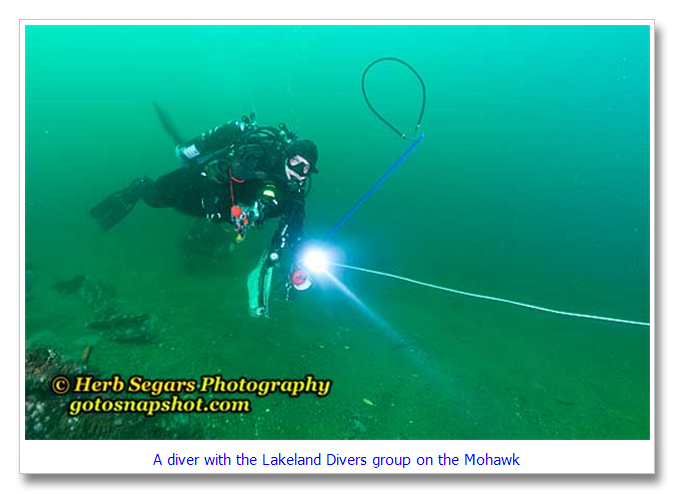
After the divers headed up their anchor line, I swam around a little and I found a plaque. I had seen this plaque before and I was amazed that I was at the same spot again. The Mohawk is pretty large and yet here I was. The plaque is a dedication to Thomas A. Butler, Sr. who died on October 6, 1992. The saying on the plaque read, “Here stays a man who loved the sea.” What a great tribute to someone who loved the sea. My wife, Veronica, has a tugboat on the Axel Carlson dedicated to her – the Veronica M. It is where we both plan to spend our eternity.
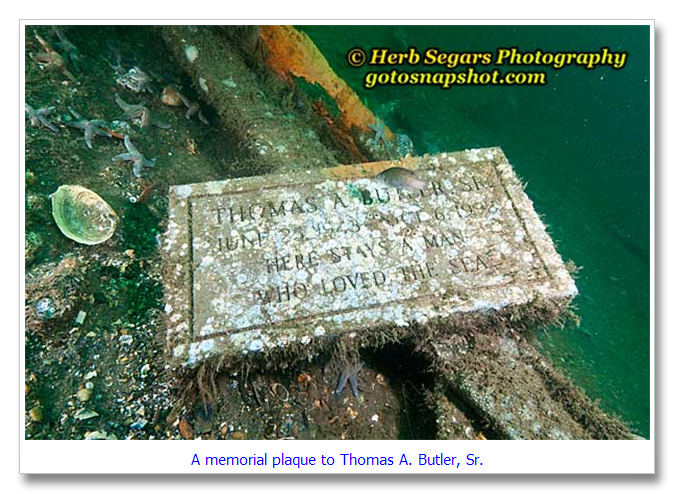
I also found a few abandoned commercial lobster traps. I am sure that they were not abandoned. They were lost somehow. A lobster fisherman would never abandon his gear. They do become traps for fish and lobster on the bottom. When divers find these derelict traps, most check to see if fish or lobster can get trapped in them and if they can, the divers will usually open them up to keep this from happening. Before long, these traps become havens for marine life.
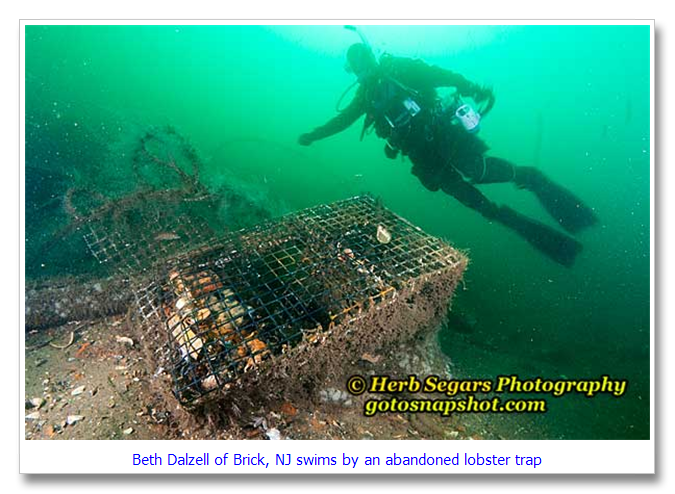
Beth and I finished our first dive and headed for the surface for our 1-1/2 hour surface interval. It is a standard practice on our boat. We talked during the surface interval. I remembered seeing a lobster near our marker buoy on the first dive and since neither Beth nor I had a bag to put the lobster into, I didn’t try and catch it. I thought that I should try on the second dive. I was telling that to Veronica, Wes and Beth and Veronica started to laugh. I asked what was funny and she said, “did you forget that you just swam over by Paul’s boat and pulled up our marker buoy to keep it from getting stuck in his ladder?” Well, we all had a good laugh on Herb about that one.
Again, Paul’s divers were in the water before we were. When Beth and I reached the bottom, they were just about done with their dives and I didn’t see any of them on my dive. The visibility had probably dropped in half from the first dive. Lower visibility makes wide angle photography that much harder. I tried to work as close as I could to my subjects and hope for the best. Another thing that I rely heavily on when taking pictures is the histogram on my camera. It tells me if I am getting a correct exposure or if I am under or over exposing. If you want to learn more about histograms, you can get info in my digital photography section of my web site here.
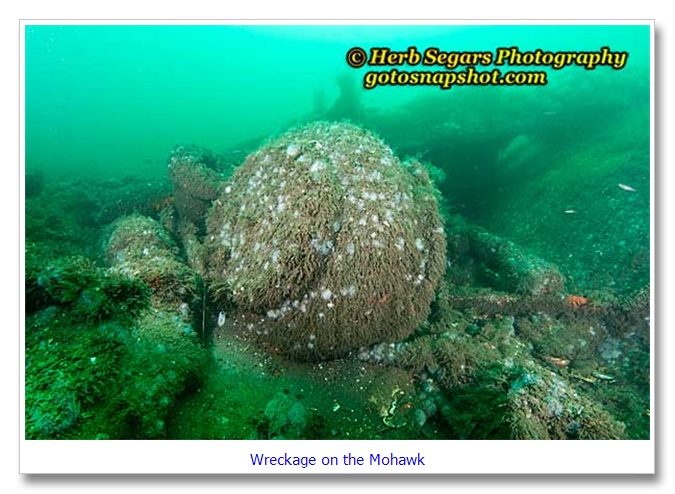
The second dive was over before we knew it and Beth and I moved our wreck anchor to a spot where it would come out easily. We got back on board, removed all our gear, recorder our logs, put cameras away and pulled our anchor. We relaxed and were soon zipping across the Atlantic waters back to our dock. It was a great day out on the ocean and we are hoping that Monday will bring more of the same.
If you would like to see more of my Mohawk photos, click here or visit my Photo Gallery, click on Shipwrecks – New Jersey and click on the Mohawk link.
© 2010, Herb Segars. All rights reserved.


Excellent dive report. This was my very first NJ wreck dive, many years ago on The Seeker, and it is still a favorite of mine.
Thank you for this write up. Was sitting reading about the Mohawk and thought I would do a quick web search and this came up. Nice to read that people are still able to get good diving on her.